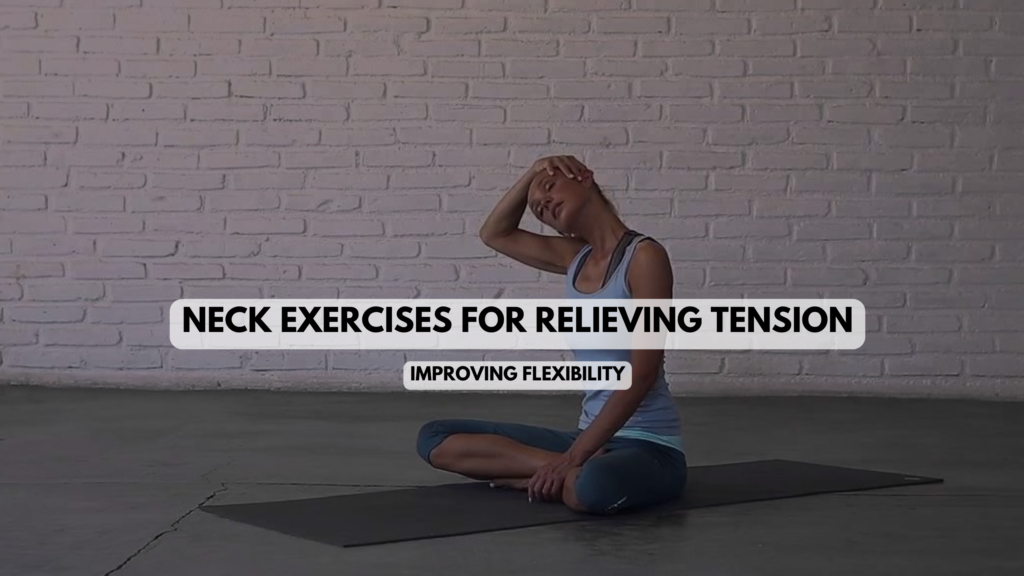The human neck, a marvel of intricate muscles and joints, allows us to tilt, turn, and nod with remarkable agility. But this constant movement can come at a cost – neck pain and stiffness. Whether it’s hunching over a computer screen, whipping your head to answer a phone call, or simply sleeping in an awkward position, our necks often bear the brunt of our daily lives.
But fear not, fellow neck-ache sufferers! This comprehensive guide is your roadmap to reclaiming neck health and freedom. Your Guide to Effective Neck Exercises explores the different types of neck pain and equips you with a potent arsenal of neck exercises to combat stiffness, boost flexibility, and keep your neck strong and supple.
Understanding Your Neck: A Musculoskeletal Masterpiece
Before diving into exercises, let’s take a quick anatomical tour of your neck. This complex region is home to seven cervical vertebrae, a network of muscles, ligaments, and tendons, and a vital bundle of nerves and blood vessels. These structures work in concert to provide your head with the remarkable range of motion we enjoy.
The primary muscles responsible for neck movement include:
- Sternocleidomastoid: This prominent muscle runs along the side of your neck and helps you tilt your head forward and sideways.
- Trapezius: This broad muscle group extends from your neck down to your mid-back and plays a crucial role in shoulder movement and posture.
- Scalene muscles: These deep neck muscles help you tilt and rotate your head.
- Suboccipital muscles: Located at the base of your skull, these muscles help you extend and retract your head.
The Spectrum of Neck Pain: From Tightness to Throbbing Aches
Neck pain can manifest in various ways, ranging from a dull ache to sharp, stabbing sensations. The type of pain you experience can offer clues about the underlying cause:

- Muscle strain: Overexertion, repetitive movements, or poor posture can strain neck muscles, leading to a tight, achy feeling.
- Whiplash: This sudden jerk of the head, often caused by accidents, can injure neck muscles and ligaments, resulting in pain, stiffness, and even dizziness.
- Arthritis: Wear and tear on the joints in your neck can lead to arthritis, causing pain, swelling, and reduced flexibility.
- Pinched nerve: A herniated disc or bone spur can compress a nerve in your neck, causing radiating pain, numbness, and weakness.
Conquering Neck Woes: Your Exercise Arsenal
Now, let’s get down to the nitty-gritty – the exercises! Here’s a carefully curated selection of stretches and strengthening moves to target different neck muscles and address various pain points:
Gentle Stretches for Improved Flexibility
- Neck rolls: Slowly roll your head in a circular motion, forward and backward, for 10 repetitions in each direction.
- Chin tucks: Gently tuck your chin towards your chest and hold for 15 seconds. Repeat 10 times.
- Side bends: Tilt your ear towards your shoulder, feeling a stretch along the opposite side of your neck. Hold for 15 seconds and repeat on the other side.
- Jaw releases: Open your mouth wide and hold for 10 seconds, then relax. Repeat 5 times.
Strengthening Moves for Enhanced Stability
- Isometric neck holds: Push your head gently against your hand (without moving your head) and hold for 10 seconds. Repeat on the other side.
- Neck raises: Lie on your back with your knees bent and feet flat on the floor. Slowly lift your head off the ground, keeping your chin tucked. Hold for 5 seconds and lower gently. Repeat 10 times.
- Shoulder shrugs: Lift your shoulders towards your ears and hold for 5 seconds. Release and repeat 10 times.
- Superman poses: Lie on your stomach with your arms and legs extended. Lift your head, chest, arms, and legs off the ground, holding for 5 seconds. Lower and repeat 10 times.
Remember:
- Always listen to your body and stop if you experience any pain.
- Start with gentle stretches and gradually progress to strengthening exercises.
- Perform each exercise with slow, controlled movements.
- Maintain good posture throughout your exercises.
- Breathe deeply and evenly during each exercise.
Bonus Tips for a Neck-Happy Life
Beyond the targeted exercises, incorporating these simple habits into your daily routine can significantly improve your neck health and prevent future pain:

Ergonomics
- Posture Perfect: Your posture, whether sitting, standing, or sleeping, plays a crucial role in neck health. When sitting, ensure your back is straight, shoulders relaxed, and ears aligned with your shoulders. Avoid slouching or hunching over your screen. Invest in an ergonomic chair that provides adequate back and neck support.
- Keyboard Calibration: Adjust your keyboard height so your elbows are bent at 90 degrees and your wrists remain straight while typing. Avoid reaching for your mouse; keep it within comfortable arm’s reach.
- Monitor Magic: Position your monitor at eye level, slightly below eye level if you have bifocals. This prevents you from craning your neck upwards, causing strain.
Tech-Savvy Tweaks
- Phone Posture: Avoid “text neck,” the hunched posture adopted while using your phone. Hold your phone at eye level, keeping your neck straight and shoulders relaxed. Consider using a phone stand to avoid constant cradling.
- Headset Harmony: Opt for a lightweight headset with good ear padding to avoid neck strain from holding a phone between your ear and shoulder.
- App Attack: Download posture reminder apps that gently nudge you to adjust your posture throughout the day.
Movement Matters
- Frequent Breaks: Don’t stay glued to your chair for hours. Take regular breaks to get up and move around. Stretch your neck, walk for a few minutes, or do some light shoulder rolls.
- Neck-Specific Stretches: Integrate gentle neck stretches throughout your day, even while standing in line or watching TV. Simple side bends, chin tucks and neck rolls can do wonders for relieving tension.
- Yoga and Pilates: Consider incorporating yoga or Pilates into your routine. These practices emphasize proper posture and core strength, which can significantly benefit your neck health.
Sleep Savvy
- Pillow Power: Choose a supportive pillow that cradles your neck in a neutral position. Avoid using overly fluffy pillows that force your head at an unnatural angle.
- Sleeping Positions: Side sleeping is generally considered the best position for neck health. Avoid sleeping on your stomach, which can strain your neck muscles.
- Stress Busters: Chronic stress can exacerbate neck pain. Practice relaxation techniques like deep breathing, meditation, or yoga to manage stress and promote overall well-being.
Remember: Consistency is key. By incorporating these simple tips and exercises into your daily routine, you can bid farewell to neck pain and stiffness and enjoy a life of pain-free head tilts, turns, and nods.
Disclaimer: This information is not intended as a substitute for professional medical advice. Always consult your doctor before starting any new exercise program, especially if you have any underlying health conditions.
Resources & References
- American Academy of Orthopaedic Surgeons: https://orthoinfo.aaos.org/en/diseases–conditions/neck-pain/
- Mayo Clinic: https://www.mayoclinic.org/diseases-conditions/neck-pain/doctors-departments/ddc-20375588
- National Institute of Arthritis and Musculoskeletal and Skin Diseases: https://www.niams.nih.gov/
FAQs – Neck Exercises
How often should I do neck exercises?
It’s generally recommended to do neck exercises 2-3 times per day, especially if you spend a lot of time sitting or looking down at your phone. Each session should take around 5-10 minutes.
However, it’s important to listen to your body and stop if you experience any pain. If you have any pre-existing neck conditions, it’s always best to consult with your doctor before starting any new exercise program.
What are the best neck exercises for pain?
Some of the best neck exercises for pain relief include:
- Neck rolls: Slowly roll your head in a circular motion, forward and backward, for 10 repetitions in each direction.
- Chin tucks: Gently tuck your chin towards your chest and hold for 15 seconds. Repeat 10 times.
- Side bends: Tilt your ear towards your shoulder, feeling a stretch along the opposite side of your neck. Hold for 15 seconds and repeat on the other side.
- Isometric neck holds: Push your head gently against your hand (without moving your head) and hold for 10 seconds. Repeat on the other side.
These exercises can help to stretch and strengthen the muscles in your neck, which can help to reduce pain and improve flexibility.
Can neck exercises help with headaches?
Yes, neck exercises can help with headaches in some cases. Tension headaches, which are often caused by muscle tension in the neck and shoulders, can be relieved by stretching and strengthening the muscles in these areas. However, it’s important to note that neck exercises may not be effective for all types of headaches. If you have chronic headaches, it’s important to see a doctor to rule out any underlying medical conditions.
Are there any risks associated with doing neck exercises?
While neck exercises are generally safe for most people, there are a few risks to be aware of. These include:
- Muscle strain: If you push yourself too hard or do the exercises incorrectly, you can strain your neck muscles.
- Dizziness: Some neck exercises can cause dizziness, especially if you have a history of inner ear problems.
- Increased pain: If you have any pre-existing neck pain, it’s important to start with gentle exercises and gradually increase the intensity. If your pain worsens, stop the exercises and see a doctor.
It’s always best to start with gentle exercises and progress slowly to avoid any risks. If you have any concerns, talk to your doctor before starting any new exercise program.
What can I do to prevent neck pain in the first place?
There are a few things you can do to prevent neck pain in the first place, such as:
- Maintain good posture: When sitting, standing, or sleeping, make sure your spine is straight and your shoulders are relaxed.
- Take breaks from sitting: If you spend a lot of time sitting, get up and move around every 30 minutes or so.
- Stretch your neck regularly: Even a few minutes of neck stretches each day can help to prevent pain and stiffness.
- Use an ergonomic workstation: If you work at a computer, make sure your workstation is set up ergonomically to avoid straining your neck and shoulders.
By following these tips, you can help to keep your neck healthy and pain-free.


